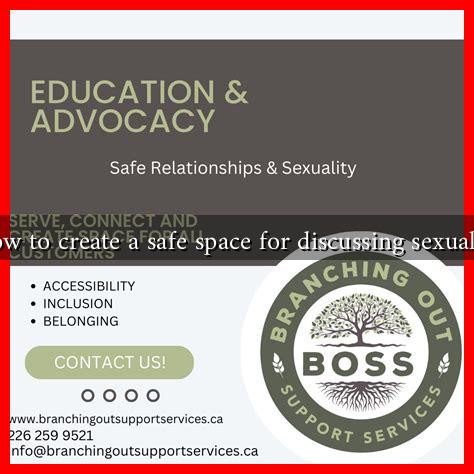-
Table of Contents
- How to Create a Safe Space for Discussing Sexuality
- Understanding the Importance of Safe Spaces
- Key Strategies for Creating a Safe Space
- 1. Set Ground Rules
- 2. Use Inclusive Language
- 3. Provide Resources
- 4. Foster a Non-Judgmental Atmosphere
- Case Studies: Successful Safe Spaces
- Statistics Highlighting the Need for Safe Spaces
- Conclusion
How to Create a Safe Space for Discussing Sexuality
In today’s society, discussions about sexuality are often fraught with discomfort, stigma, and misunderstanding. Creating a safe space for these conversations is essential for fostering open dialogue, promoting education, and supporting individuals in their sexual health journeys. This article will explore effective strategies for establishing such environments, drawing on research, case studies, and practical examples.
Understanding the Importance of Safe Spaces
Safe spaces are environments where individuals feel secure to express their thoughts, feelings, and experiences without fear of judgment or backlash. When it comes to discussing sexuality, these spaces are crucial for several reasons:
- Encouraging Open Dialogue: Safe spaces allow individuals to share their experiences and questions, leading to greater understanding and acceptance.
- Reducing Stigma: By normalizing conversations about sexuality, we can combat the stigma that often surrounds these topics.
- Promoting Education: Safe spaces can serve as platforms for sexual education, helping individuals make informed decisions about their sexual health.
Key Strategies for Creating a Safe Space
Establishing a safe space for discussing sexuality requires intentionality and commitment. Here are some effective strategies:
1. Set Ground Rules
Establishing clear guidelines can help create a respectful environment. Consider the following:
- Encourage active listening.
- Promote confidentiality—what is shared in the space stays in the space.
- Foster respect for differing opinions and experiences.
2. Use Inclusive Language
Language plays a significant role in creating a safe space. Use terms that are inclusive and affirming of all sexual orientations and identities. For example:
- Use “partner” instead of assuming “boyfriend” or “girlfriend.”
- Avoid jargon that may alienate individuals unfamiliar with specific terms.
3. Provide Resources
Offering educational materials can empower individuals to engage in informed discussions. Consider providing:
- Books and articles on sexual health and education.
- Access to local sexual health clinics and counseling services.
- Links to reputable online resources, such as Planned Parenthood or Scarleteen.
4. Foster a Non-Judgmental Atmosphere
Encouraging vulnerability is key to creating a safe space. Leaders and facilitators should model non-judgmental attitudes by:
- Validating feelings and experiences.
- Avoiding personal biases in discussions.
- Responding with empathy and understanding.
Case Studies: Successful Safe Spaces
Several organizations have successfully created safe spaces for discussing sexuality. For instance:
- The Trevor Project: This organization provides crisis intervention and suicide prevention services to LGBTQ+ youth, fostering a safe environment for discussions about sexuality and identity.
- Sexual Health Clinics: Many clinics offer workshops and support groups that create safe spaces for individuals to discuss sexual health issues openly.
Statistics Highlighting the Need for Safe Spaces
Research underscores the necessity of safe spaces for discussing sexuality. According to a study by the Guttmacher Institute, nearly 50% of young people report feeling uncomfortable discussing sexual health with their peers. Furthermore, a survey by the Human Rights Campaign found that 70% of LGBTQ+ youth feel unsafe in their school environments, highlighting the urgent need for supportive spaces.
Conclusion
Creating a safe space for discussing sexuality is not just beneficial; it is essential for fostering understanding, reducing stigma, and promoting sexual health. By setting ground rules, using inclusive language, providing resources, and fostering a non-judgmental atmosphere, we can create environments where individuals feel empowered to share their experiences and learn from one another. As we continue to advocate for open discussions about sexuality, let us remember that every conversation contributes to a more informed and accepting society.

